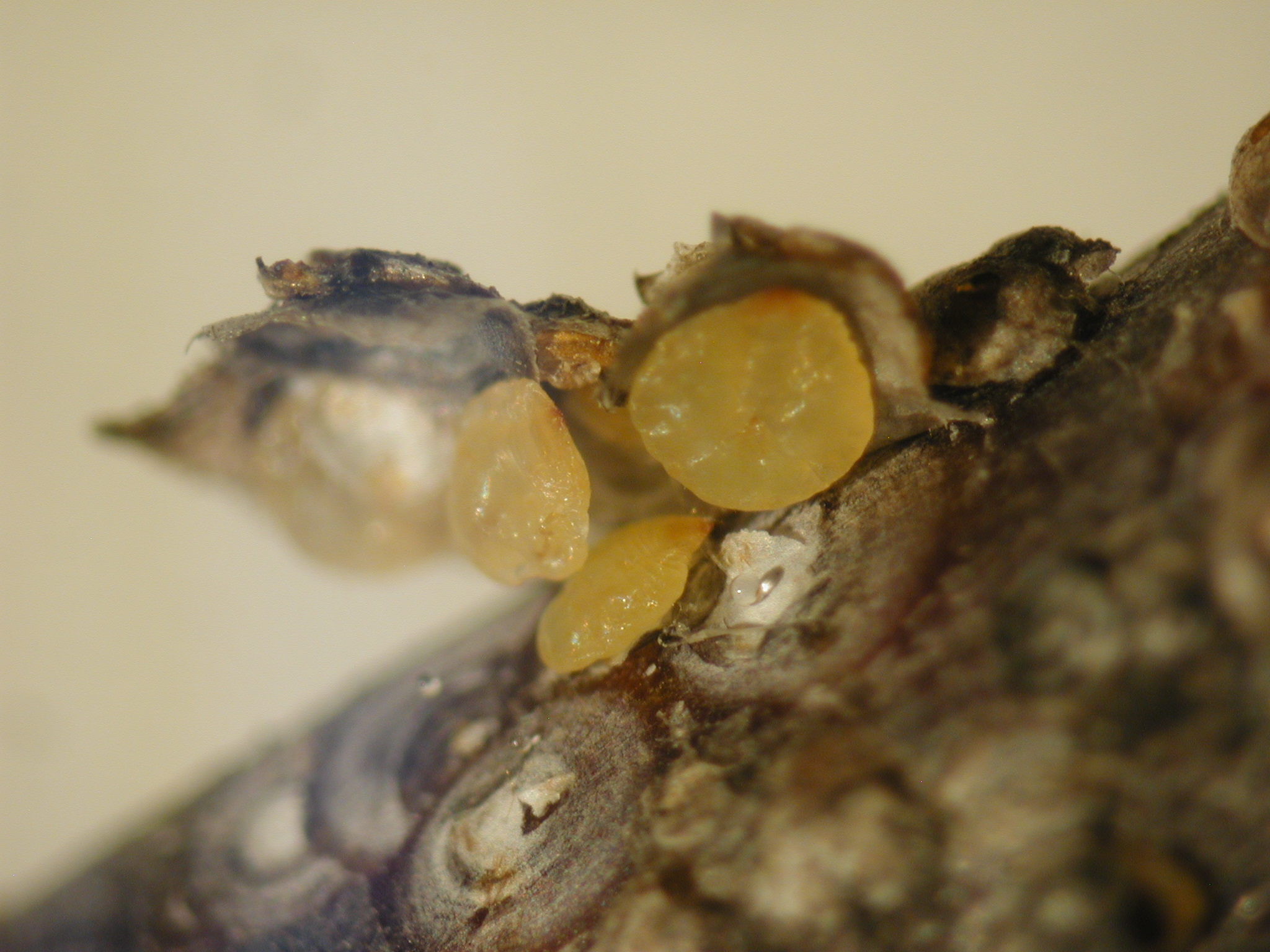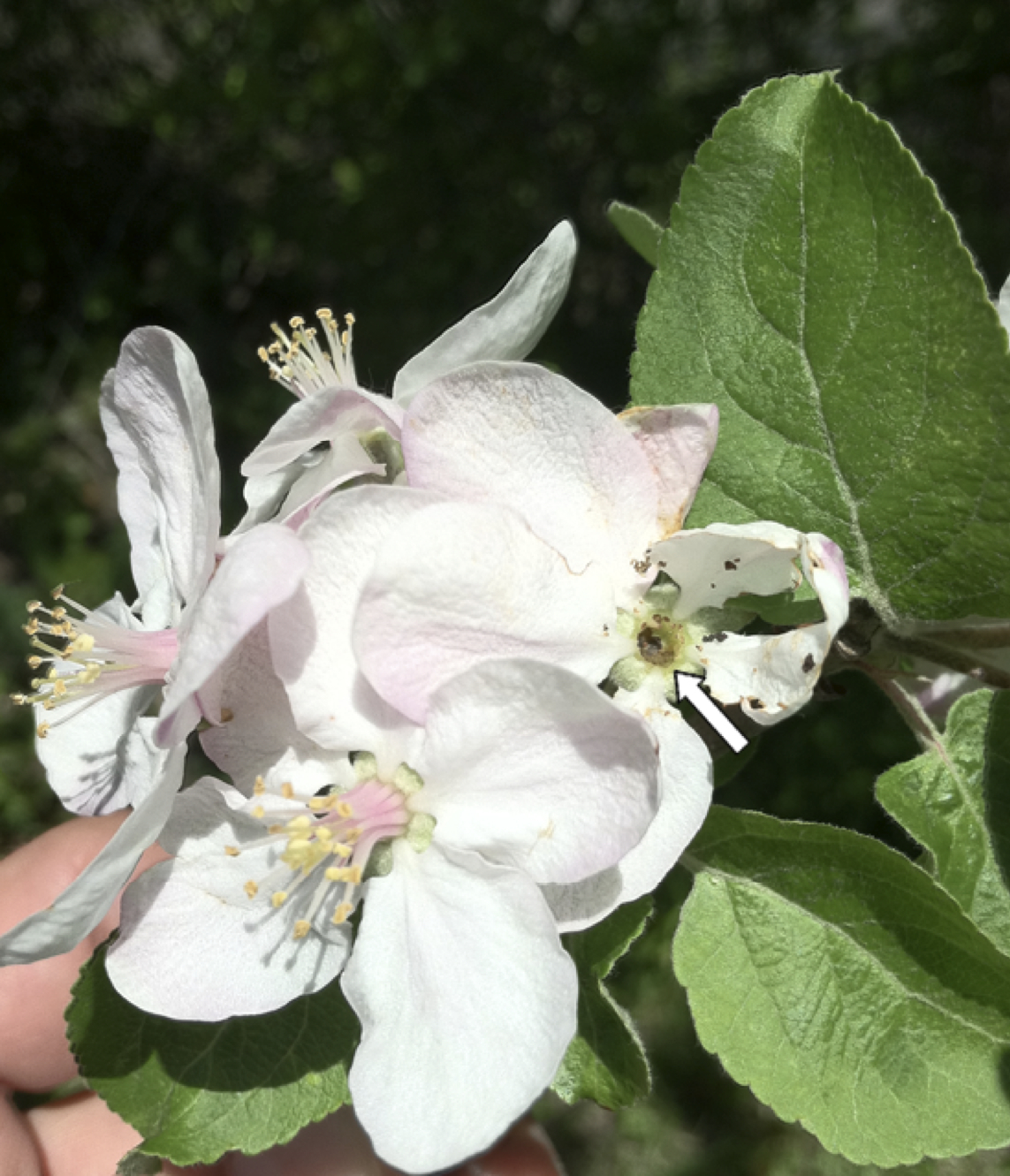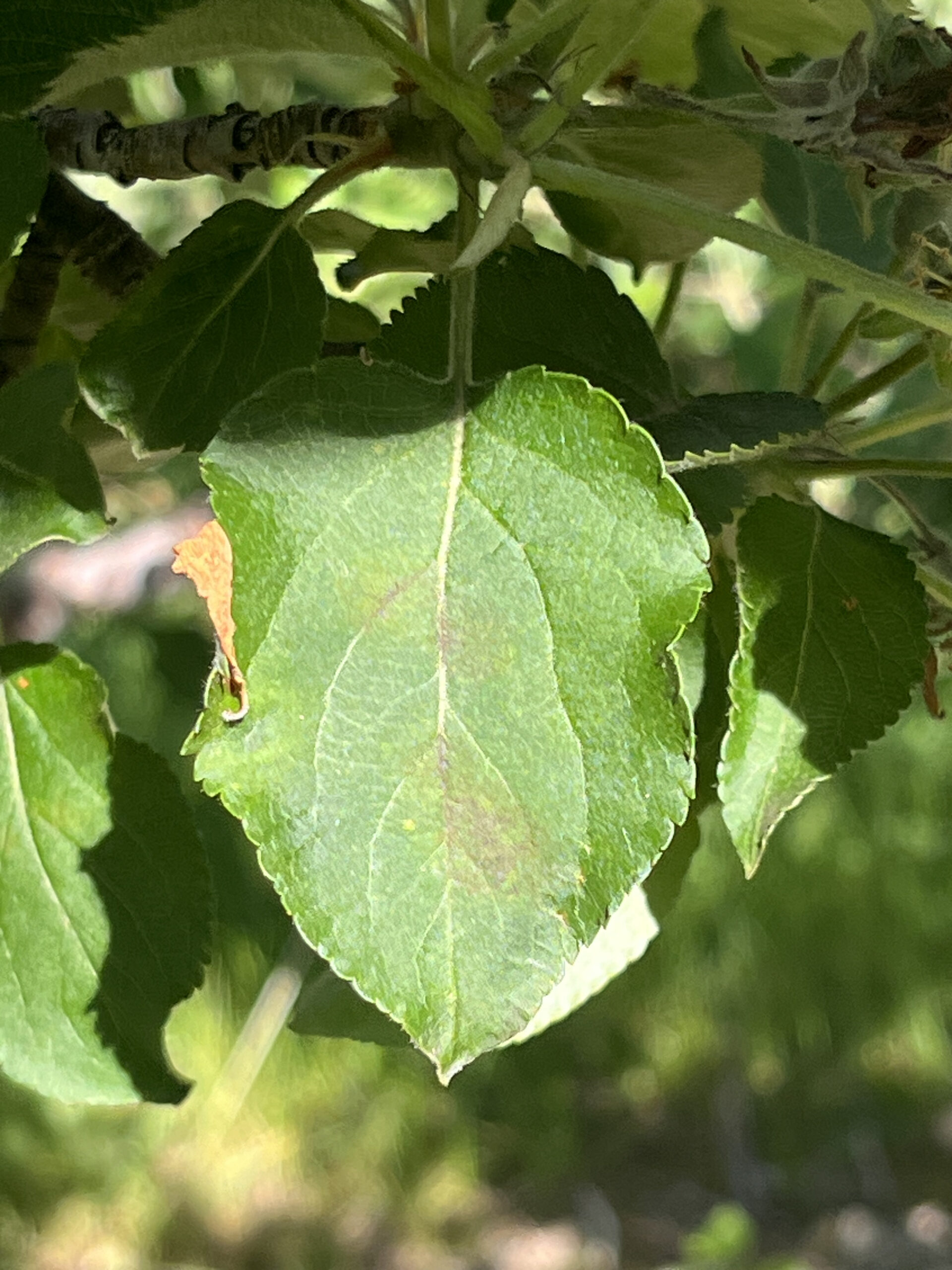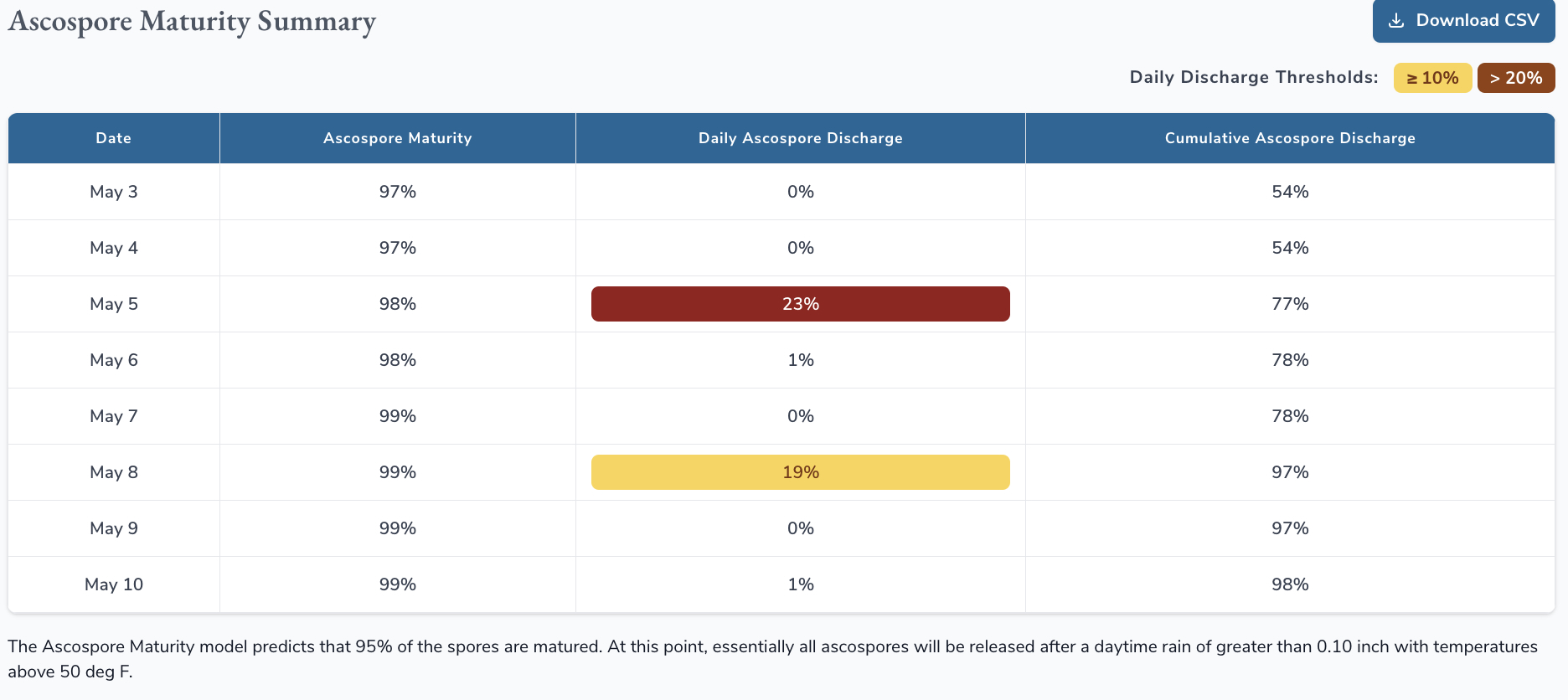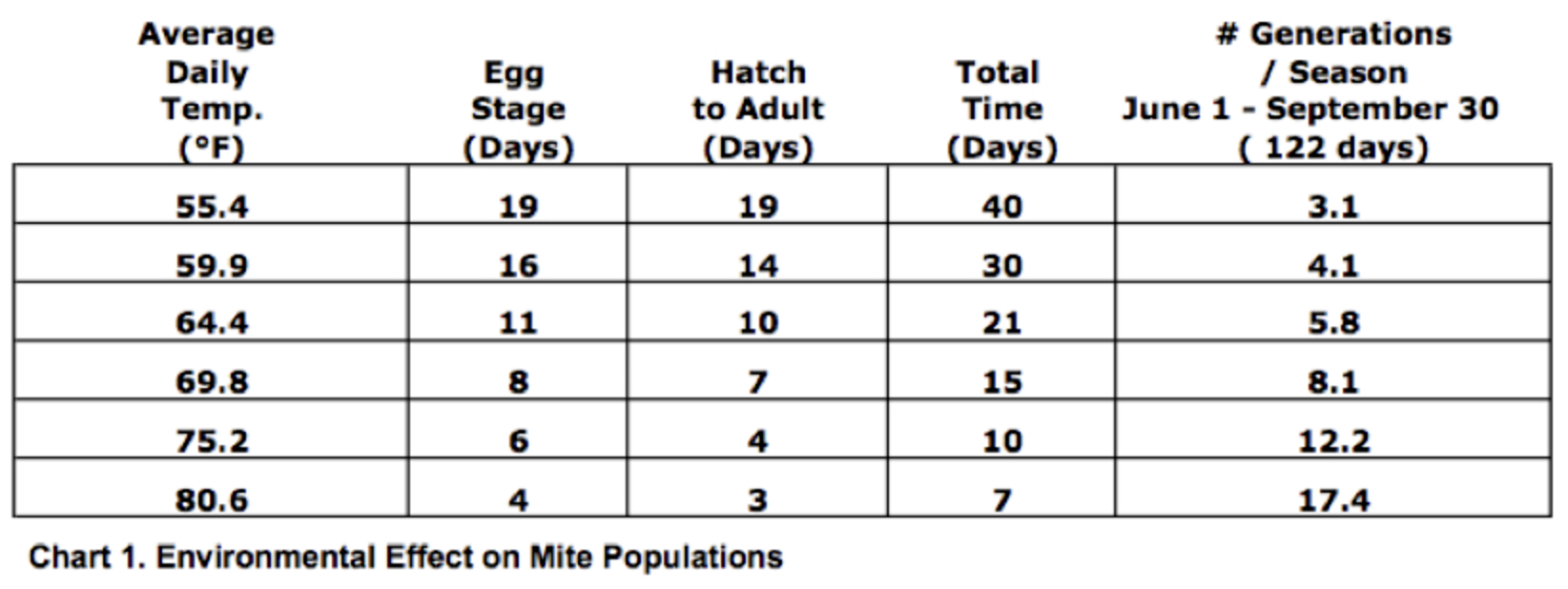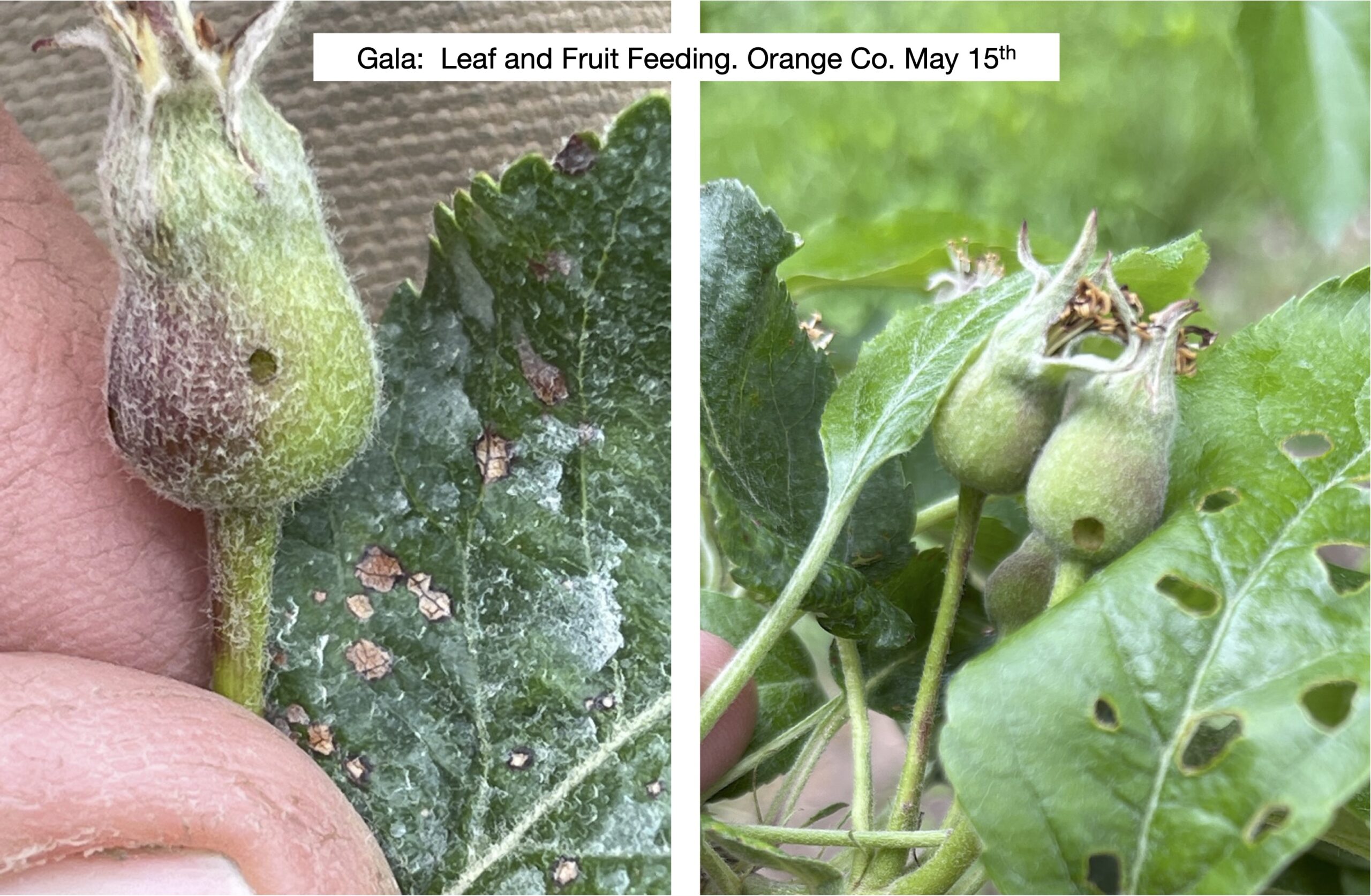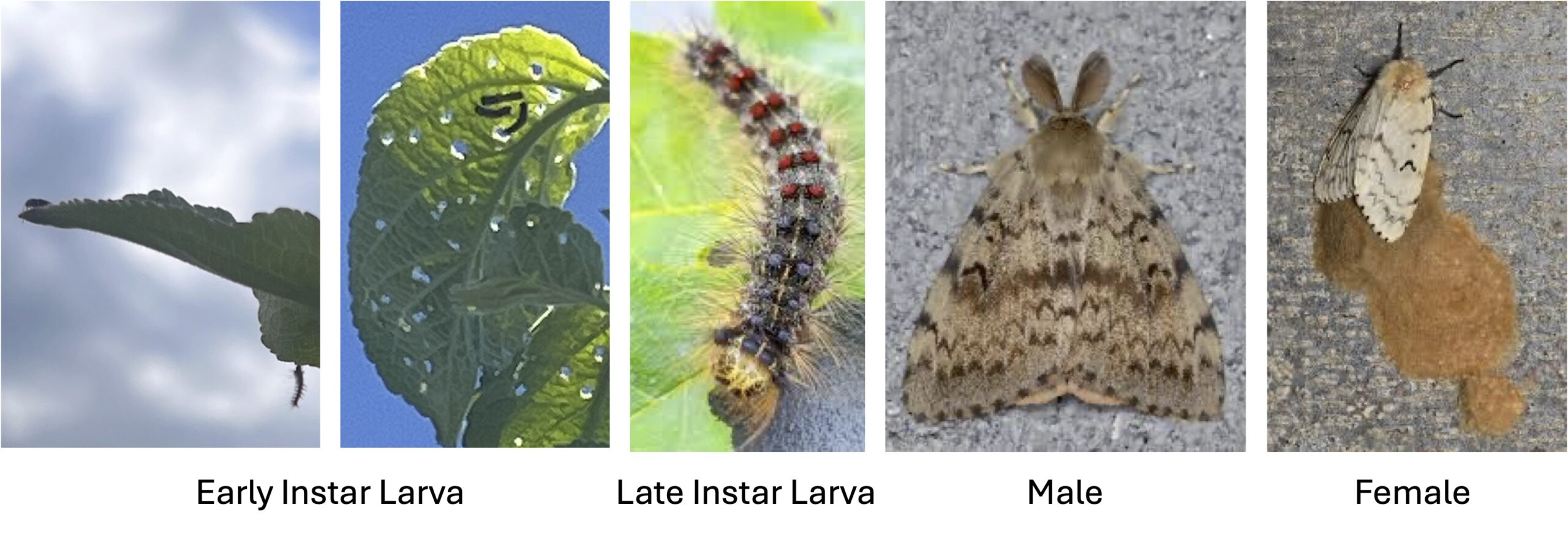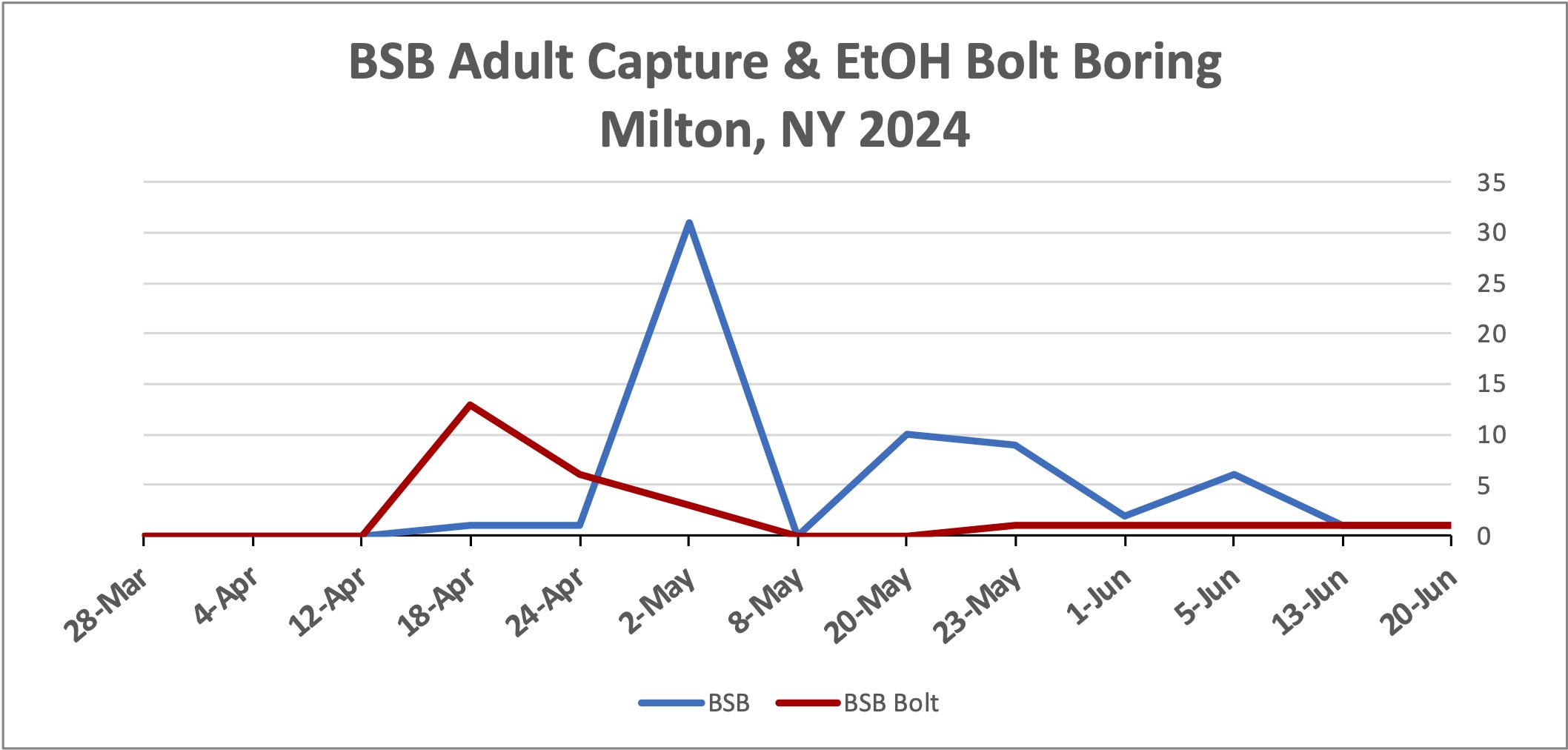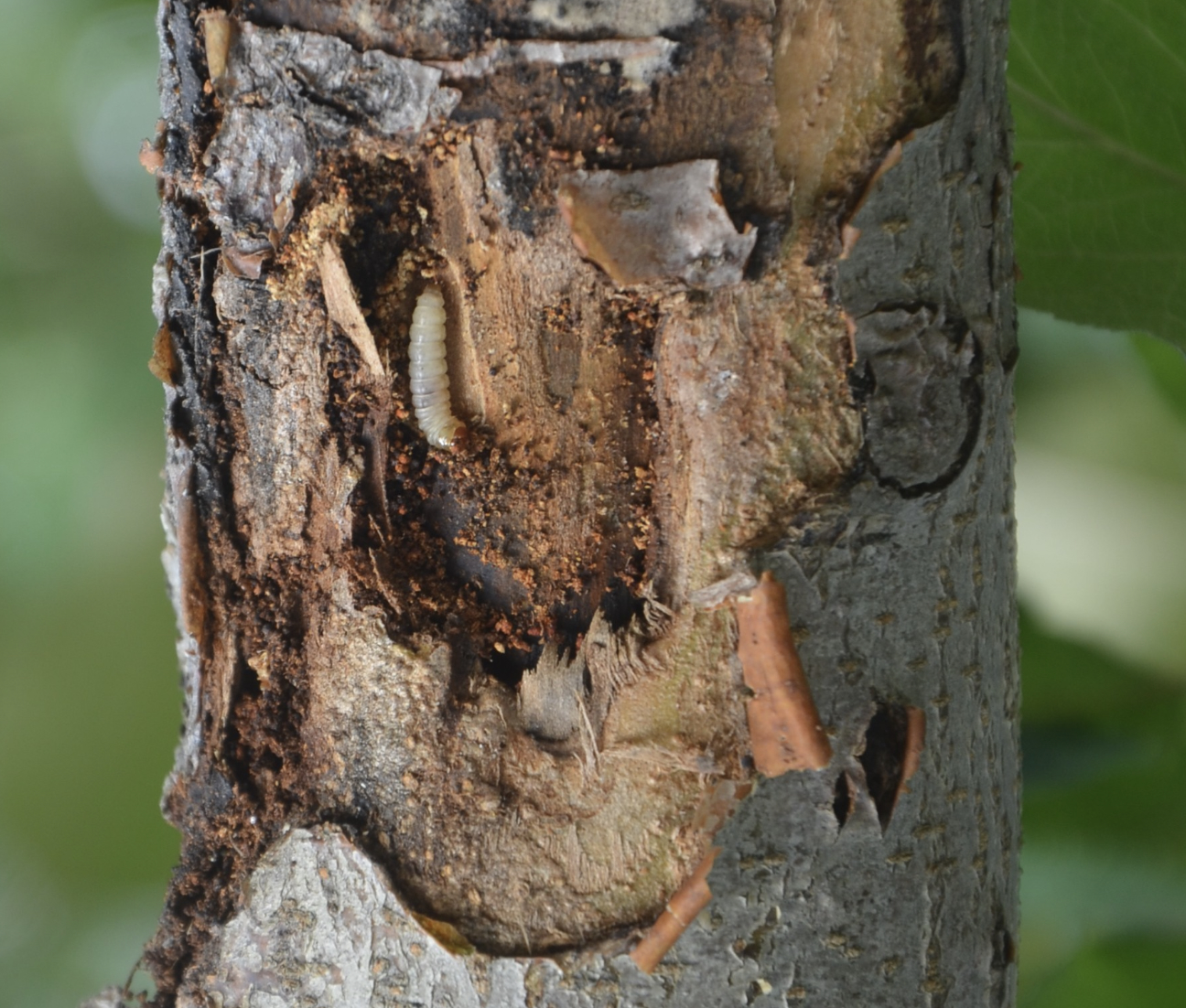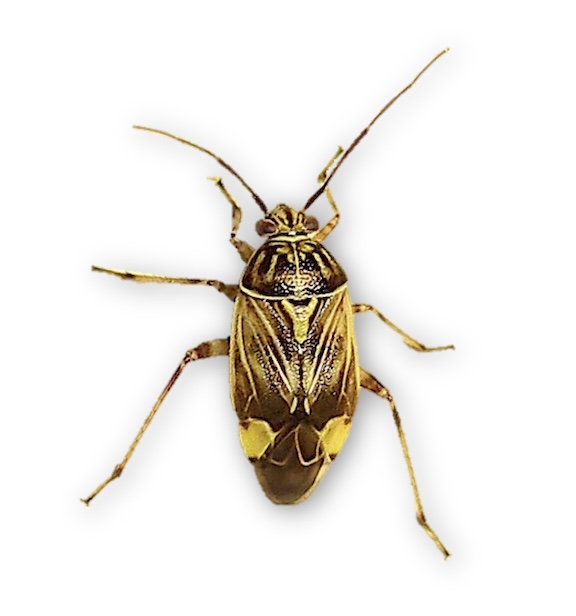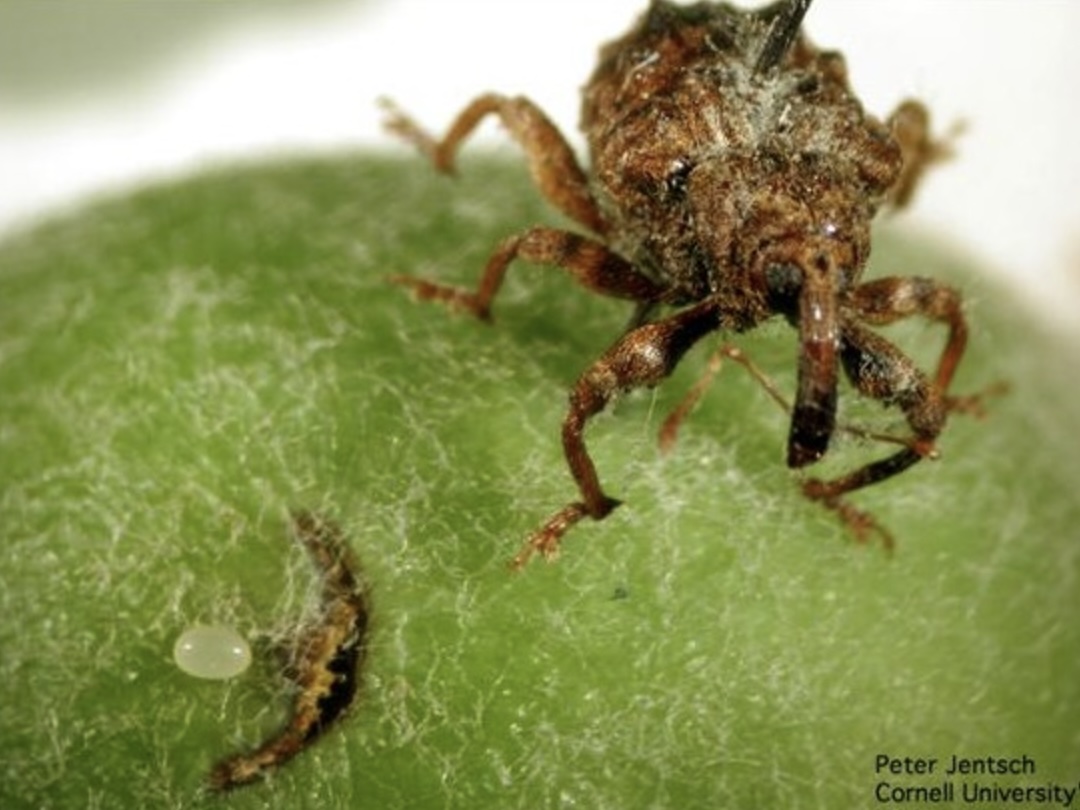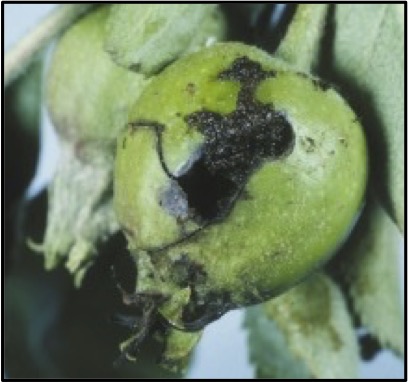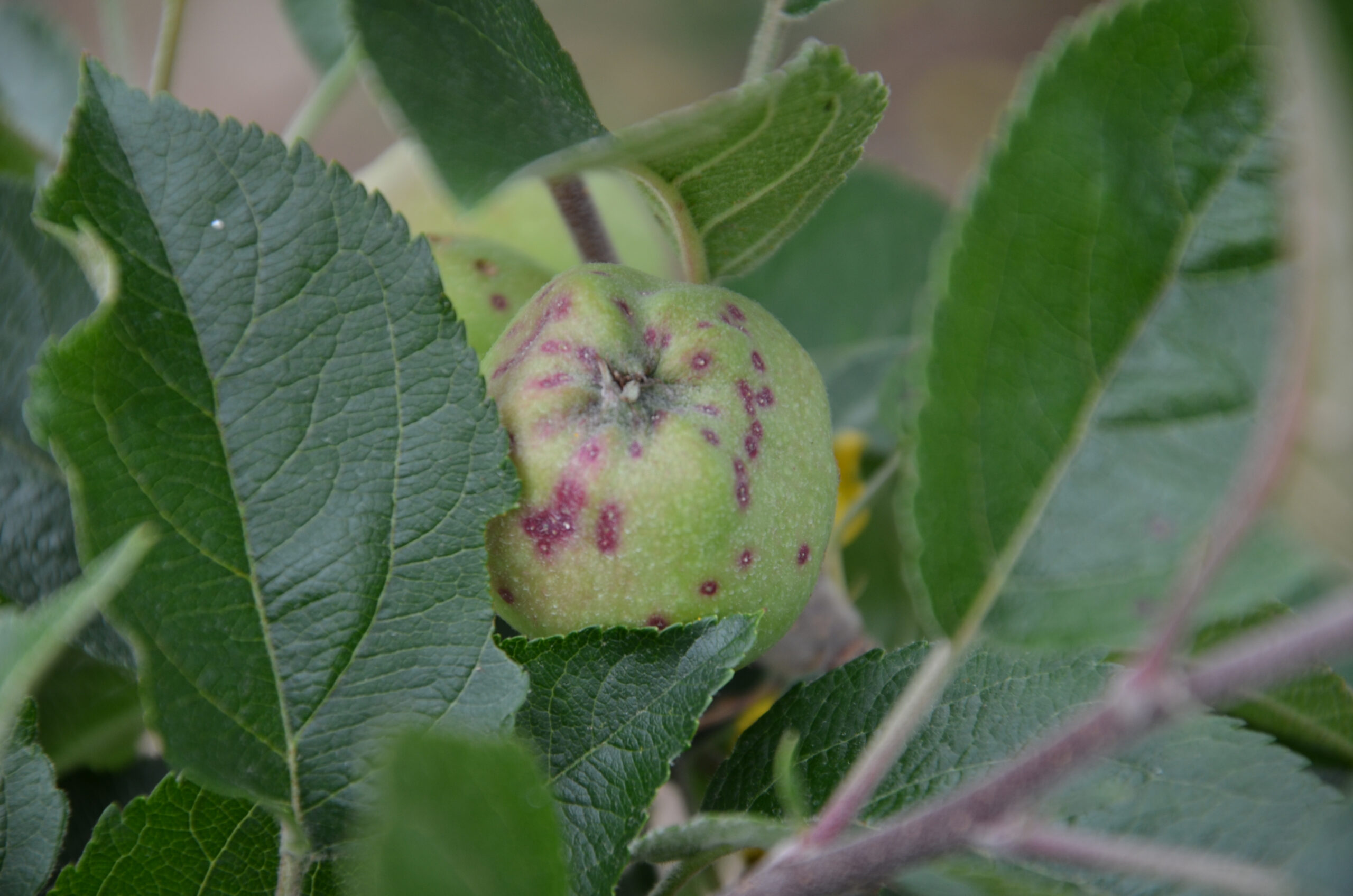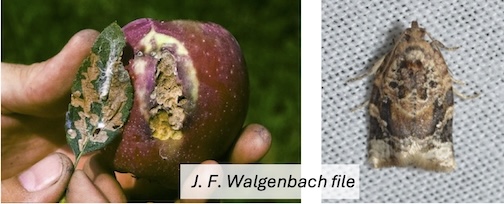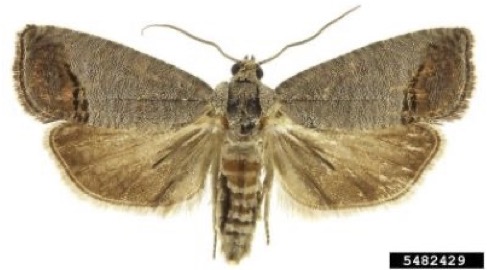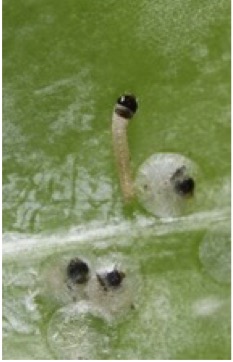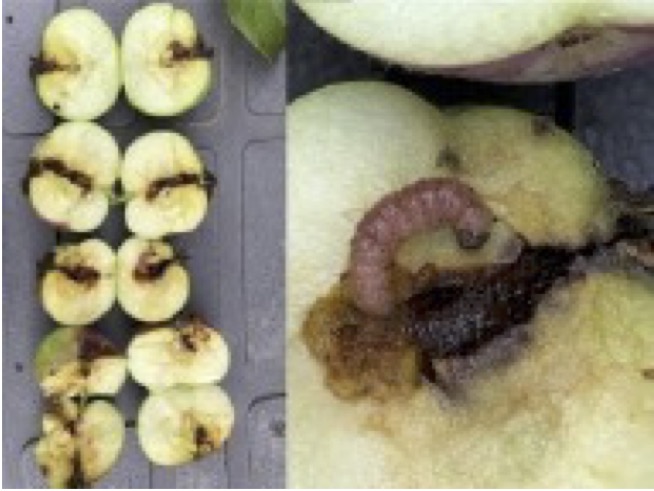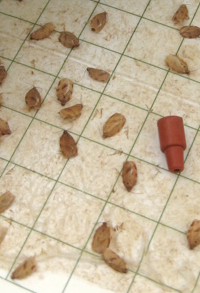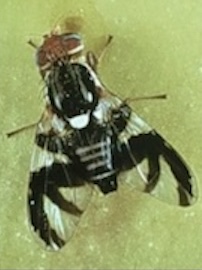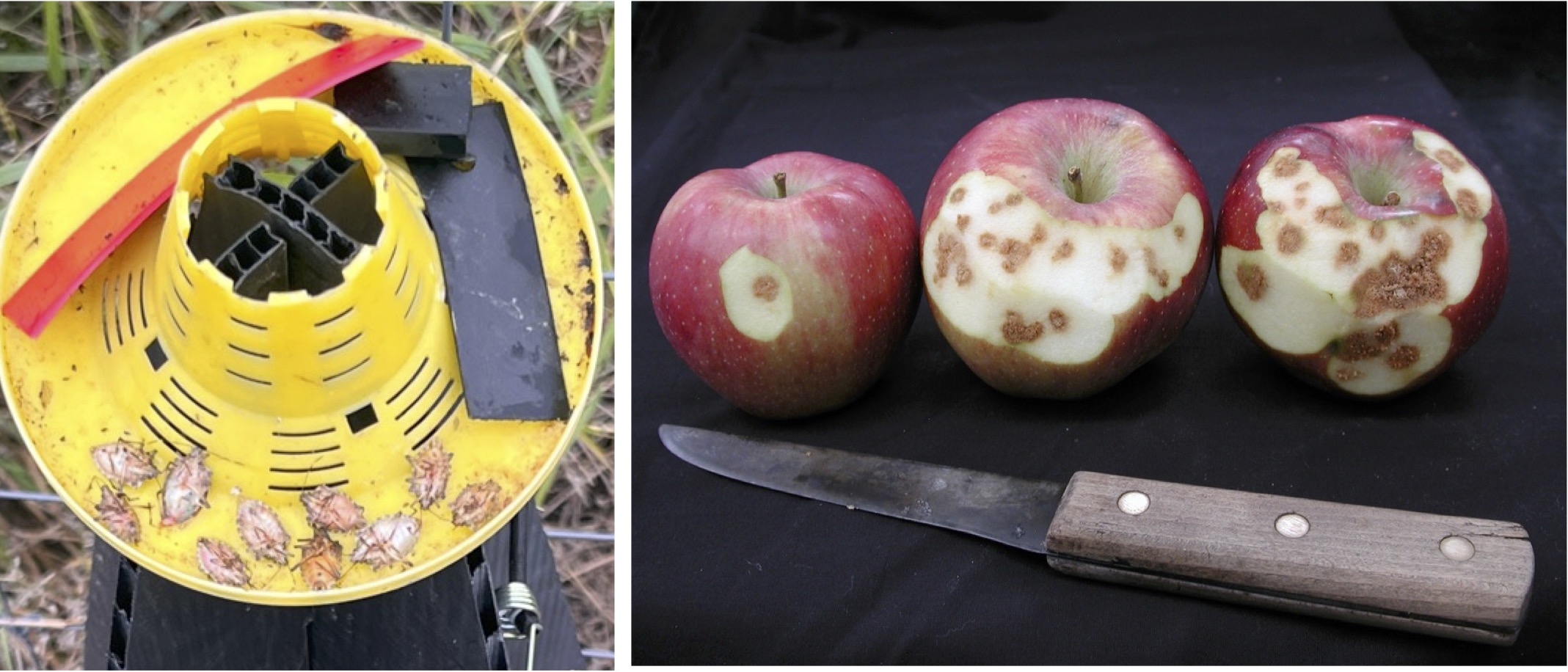2024 Factors Contributing to Pest Management in the Hudson Valley .

Rainfall accumulations & temperature events: Winter temperatures remained historically ‘mild’ with lowest temperatures in Milton, NY dipping below the teens during January 21st-22nd of 3.9o-7.0oF respectively. The lack of significant and long-term freeze events may have provided successful overwintering of endemic orchard resident insect populations such as San Jose Scale, Wooly Apple Aphid, the mite complex…. during the onset of the 2024 season.
Total rainfall accumulations for the 2024 growing season from March 1st to September 1st in Milton, NY was 26.15”, slightly lower than 2023 with September and October under severe drought conditions totaling 0.91″. The start of the growing season began relatively mild in March with higher-than-average rainfall. Rainfall accumulations of 6.76” in March (3.6” Ave.) were well above average with 4.35” of rainfall in April (3.8” Ave.). Moderate temperatures throughout April ranged from 37.0oF to 74.9oF, increasing floral development from Tight Cluster to Pink in McIntosh by the 21st April. A light freeze event occurred across the region on 26th of April with temperatures dropping to 27oF in colder sites across the Mid-Hudson Valley. Average rainfall in May of 3.83” was below average (4.4” Ave.) yet having ample ground moisture for tree growth. Mild temperatures held through May averaging 62.6oF with McIntosh King Bloom beginning by the 1st May. Bloom lasted 7-days with Petal Fall (PF) completed on 8th of May. Rainfall totaling 1.56″ fell in three events during the bloom period in Milton, NY.
June experienced average rain resulting in 4.21” (” Ave.), followed by mild temperature and relatively consistent rains throughout the month. July experienced low levels of rain resulting in 2.92” (4.2” Ave.) with five days at or above 90oF, requiring fruit sunburn protection and intermittent orchard irrigation.
Early apple scab in susceptible varieties produced very high levels of secondary innoculum causing high mid-season infections. August experienced slightly lower than normal rainfall with accumulations of 4.08” (4.2” Ave.), yet providing ideal conditions for development of cell expansion for growth, especially for early season Sweetango and Early Gala. September had significant drought conditions throughout the month with 0.89″ of rainfall requiring significant amounts of daily irrigation. Many farms invested in widening, deepening and developing new ponds given the likelihood of continued extreme weather conditions.
The May freeze event caused low levels of fruit losses to lower scaffold flowers and early fruitlets in low lying blocks. Peach, Apricot and Nectarine were lightly thinned due to cold temperatures with a heavy crop of Sweet Cherry available on well ‘drained’ hill sites. Thinning began during bloom through petal fall for moderate thinning in early May, with little negative impact on fruit growth rate from NAA during this stage. Inhibition of strong thinning occurred as king fruitlets reached 5-10 mm fruit, due to low temperatures holding until the 17th May.
Harvest fruit size was generally strong with exceptional color and size, especially in the upper canopy and orchards under intensive irrigation and summer pruning. In tall spindle rows, the crop could not be fully supported without secondary upright 2’ x 4’ posts in some orchards to reinforce upper limbs or top wire. Even so, entire rows collapsed from uneven loads or downhill posturing, primarily in angled end post systems. H-Brace systems with heavy upper canopy crop also succumbing to the weight and wind during mid-late season. Many difficulties aside, mid and lower Hudson Valley orchard sites did provided growers with a full harvest of most varieties. PYO operations faired well with good weekend weather.
Disease Note: During bloom on the 5th of May, a large discharge of ascospores (28%) was released during the latter primary Apple Scab discharge period. This resulted in regional Apple Scab outbreaks across varieties leading to a surge in secondary scab infections for orchards without protective fungicides in place. Apple Scab was observed in Red Delicious foliage by 20th May in Clintondale, NY. On a number of varieties such as Ruby Frost and Snap Dragon, Apple Scab was observed on fruit prior to observations of foliar expression.
Mildew was observed at moderate levels beginning in mid-spring of highly susceptible varieties such as Ginger Gold and Snapdragon.
The first Fireblight infection occurred May 7-9th during bloom in Orange and Ulster Counties. As is the nature of late blooming apple varieties used for hard cider, fireblight was most prevalent in susceptible varieties, primarily in Dabinette and Yarlington Mills.
Tree phenology: Moderating temperatures and adequate rainfall throughout March supported the onset of bud development with green-tip on March 18th in McIntosh. Tight cluster followed on 14th April with full Pink by the 21st. Full Bloom occurred on 1st May followed by very warm temperatures. A short 7-day bloom period to >80% PF was 2 days shorter than the 9-day average occurring May 8th. King fruit development began during unseasonable warm weather, sizing above 7-8mm, then pre-disposing fruit to cold temperatures through to mid-May with crop load management beginning in earnest on the 17th as temperatures moves into the 70-80oF mark. Degree day accumulations at PF of 53143 was 31DD higher than the 45 yr. mean, 24DD50 above average. A ‘narrow’ temperature range of 44.5oF to 85.1oF occurred during bloom (McIntosh: May 1-May 8), providing the honeybee near ideal conditions to pollinate flowers during the short bloom period. Cold temperatures followed ranging between 42oF and mid-60’s with a single day at 77 oF. Relatively few hail events were reported during the season in the mid-Hudson Valley. Very early harvested fruit such as Early Gala and Sweetango had ample soil moisture from moderate weekly rain events and good sunlight. Drought conditions required significant irrigation efforts, challenging fruit size from September 1st through 20th November with 1.56″ in Milton, NY. Bitter pit was prevalent across most late season varieties at low to moderate levels, supported by calcium applications.
Phytophagous Mites: European Red Mite (ERM): Panonychus ulmi. Mite feed on apple foliage, killing cells containing chlorophyll, reducing leaf photosynthesis ie carbohydrate production, leading to lower fruit sugar content. Very few overwintering eggs were observed in varieties infested during the previous season. Despite frequent rains in 2024, mite population began to build in Ruby Frost by mid-May as temperatures increased (Chart 1). ERM management was required by June 12th in Sommerset Red Streak and Brown Snout cider varieties in Orange County, NY. By late July Gala expressed individual tree ‘pockets’ of very high populations of European Red Mite (ERM) adults, found during weekly scouting in tree assessments, caused the onset of bronzing. Snapdragon was found with both ERM and Two Spotted Spider Mite (TSSM) the following week, followed by infested rows of HoneyCrisp, 100 meter to leeward, suggesting mite ‘arrived’ from a different location.
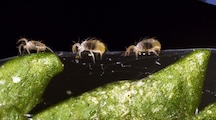
Twospotted spider mites traveling on webbing that is present on a leaf. Courtesy: David Cappaert, Bugwood.org
Generally, ERM arise from overwintering eggs, often laid on apple during the prior season, then giving rise to mid-late season infestations. Mites move about by crawling from leaf to leaf, tree to tree. TSSM typically move into apple during dry periods. Mite species are also capable of traveling from bronzed trees to healthy trees by creating silk threads and ‘sailing’ across the orchard to develop colonies in a more favorable environment. Scientists acknowledge that electrostatic forces may be acting in conjunction with light winds to facilitate spider flight, with research showing that wind is not necessary.
Two Spotted Spider Mite (TSSM): Tetranychus urtica often reside on weed host plants in tree rows, moving into the canopy after summer herbicide applications kill the primary host plant. Populations can ‘flair’ in high numbers to cause damage to foliage, observed throughout the mid-late season at moderate levels. Significant injury occurred by mid-July through September in unmanaged blocks. TSSM cause higher levels of injury to foliage and as such employ lower population levels for the onset of management. Populations of both ERM and TSSM can increase very quickly as temperatures increase during the early summer. Timely management is essential to preserve leaf carbohydrate production, and critical during times of drought.
Many varieties including Snapdragon and HoneyCrisp were found with both ERM and TSSM during mid-season in 2024.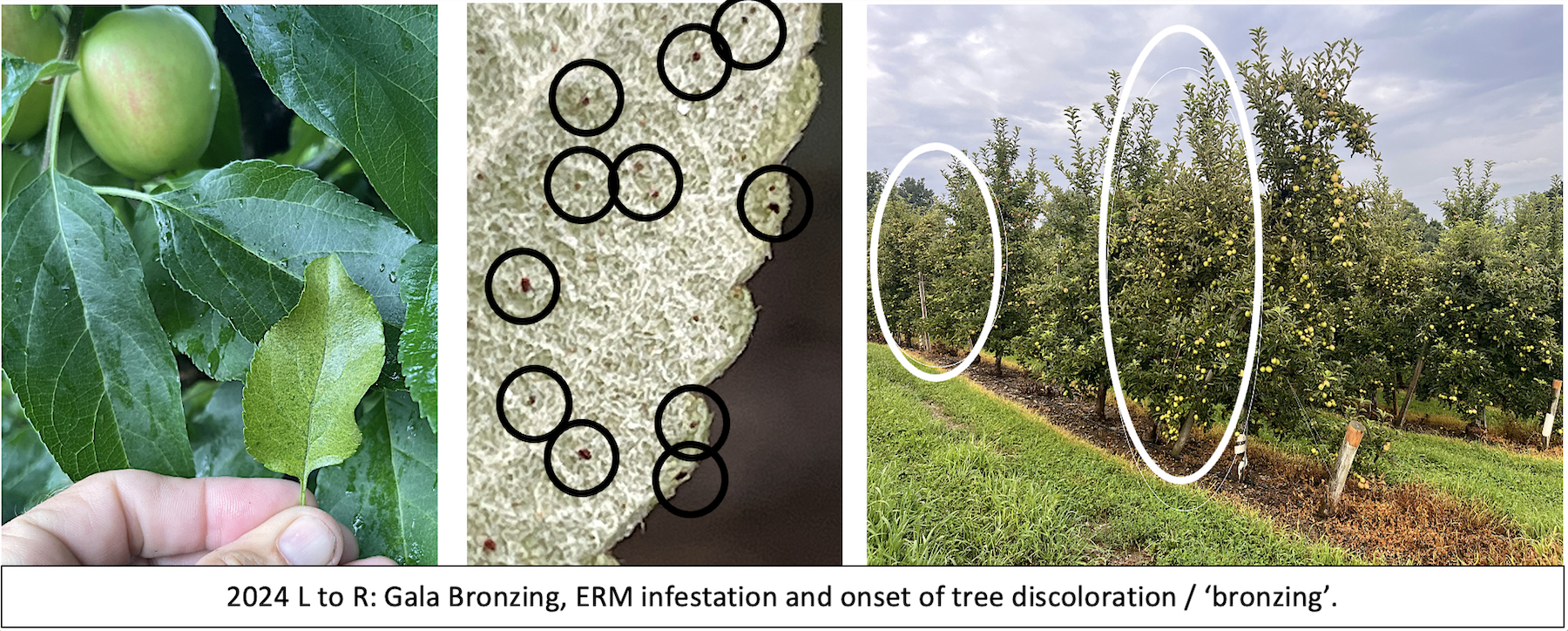
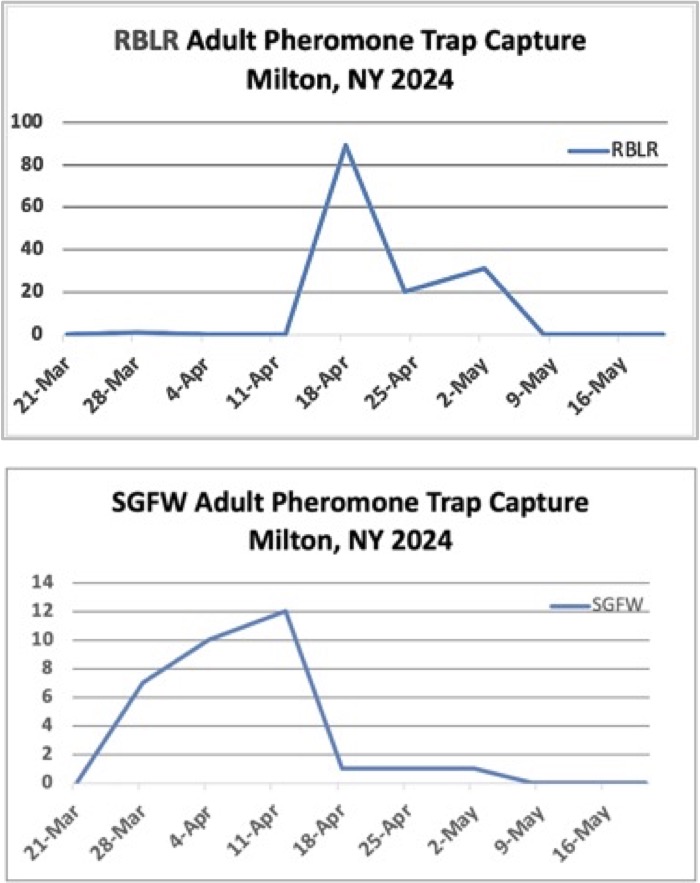 Lepidopteran and Beetle Pheromone traps placed in Milton on the 12th of March captured the first seasonal Redbanded Leafroller (RBLR) Argyrotaenia velutinana (Walker), of the family Tortricidae at 1/trap/wk. on 17th March with 1st gen. peak flight on the 14th April at 55/trap/wk. Larva were observed in very low levels during bloom on through the petal fall period.
Lepidopteran and Beetle Pheromone traps placed in Milton on the 12th of March captured the first seasonal Redbanded Leafroller (RBLR) Argyrotaenia velutinana (Walker), of the family Tortricidae at 1/trap/wk. on 17th March with 1st gen. peak flight on the 14th April at 55/trap/wk. Larva were observed in very low levels during bloom on through the petal fall period.
The overwintering larvae of the Speckled Green Fruit Worm (SGFW) Orthosia hibisci emerging as adults the week of the 24th March peaked on the 11th April at 12/trap/wk. Larva were observed in very low levels during the pre-bloom through petal fall periods with low fruit injury levels.
Gypsy Moth Lymantria dispar larva, was recently reclassified as Spongy Moth.
First larva were observed by the 1st of May in Orange and southern Ulster Counties, blown into perimeter apple trees from hardwood forests. Significant injury to newly developed foliage occurred by the 8th with fruit injury to king fruitlets occurring during early petal fall by the 15th May in untreated blocks.
Pre-bloom Bt insecticides were very effective during early migration in managing this pest. Continued presence of wooded edge late larval populations were present throughout June, also causing significant injury to newly planted tree terminal shoots.
The Black Stem Borer (BSB) Xylosandrus germanus (Blandford), a species of Ambrosia Beetle, is a sporadic pest of apple, causing significant tree loss in commercial orchards during the 2018-24 growing seasons. First trap capture and 1st infestation of EtOH treated apple ‘bolts’ occurred on April18th. Traps for BSB were placed along the orchard edge of woodlands from which Ambrosia Beetle populations emerge. Infested tree sites included dwarfing strains of M9 rootstock (primarily M9 T-337) of Fuji and Honey Crisp, in locations with excessively drained ripped shale
outcroppings in Hudson Valley sites in Marlboro and Walden under drought or consistently wet soil conditions where trees were found expressing rapid apple decline (RAD) symptoms (tree yellowing…) and containing BSB entry sites. Dry sites were under seasonal irrigation proved to be insufficient during drought to maintain low levels of stress induced ETOH. Many sites with BSB induced RAD were observed in low lying situations with seasonal standing water. Invariably, young trees coming from nurseries appear to have insufficient root systems on M9 & often B9, to withstand extreme wet or dry soil conditions during the first few years after planting. Research studies by Dr. Jason Londo on the winter hardiness of rootstocks have shown that acclimation and de-acclimation during freeze events differs broadly across rootstock strains, also leading to tree stress (See text below).
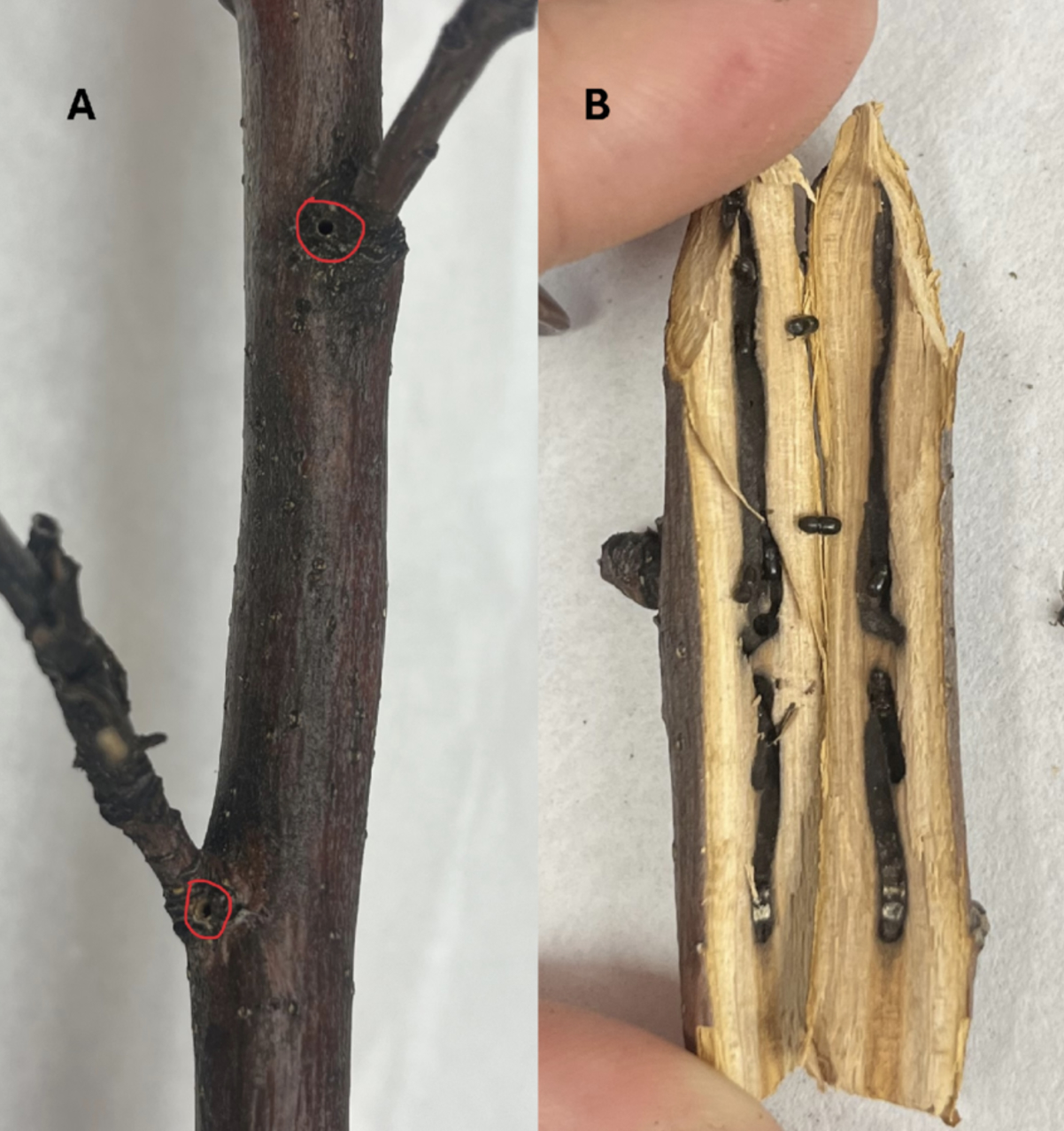
Entry sites (L) with adults and larva within galleries of the branch for reproduction (R). Image Pub. Kelsey Tobin, Cornell
Anisandrus maiche (Stark, 1936) (Coleoptera: Curculionidae: Scolytinae) is a newly found Asian invasive Ambrosia Beetle, observed in WNY infesting apple in 2024. This beetle enters into tree limbs making it more difficult to scout for. The presence of A. maiche adult beetle has yet to be confirmed in the Hudson Valley. Scouting for BSB and A. maiche should begin in mid-late April in the Hudson Valley. Observations targeting both the trunk below the 1st scaffold to the base of trees (BSB) and lower to mid scaffolds branches of young and newly planted trees, correlated to emergence of beetles, employing EtOH bottle traps to determine adult population presence.
Dr. Jason Londo (Cornell Univ. Geneva) has, in recent studies into apple rootstock winter hardiness, shown striking differences in cold temperature acclimation and de-acclimation cycling through the season. The freeze events that then kill parts or all of the rootstock appear as dying cambium and bark, eventually separating up from the trunk. Weakened trees emit ethylene (EtOH), which BSB utilize for finding and infesting trees undergoing stress. Beetles then burrow into the base of the trees, both below the soil line up to lower scaffold limbs, to create galleries for reproduction. Beetles forage for fungal spores carried into the galleries, developing into mycelia on which the larva then feed. Depending on the species of fungi, the mycelia ‘roots’ may interfere in cambium transport of water and nutrients, adding to tree stress and EtOH production.
Studies conducted at Rutgers University have shown Glufosinate-ammonium (Interline® Rely®) that can contribute to tree trunk injury under certain environmental conditions and subsequently cause tree decline and loss. Glyphosate may also play a role in tree decline. Dr. Hannah Mathers, an independent nursery crop/landscape consultant with Mathers Environmental Services, LLC, conducted research on bark splitting of nursery and landscape trees during her time at The Ohio State University. She found that drift from late-season glyphosate applications was absorbed into young trees, damaging the bark structure and reducing their winter hardiness. This resulted in bark splitting that can open these trees to various pathogens. Mathers also found that formulations of glyphosate that contain surfactants (products that increase its absorption into target weeds) increase the likelihood of damage. Herbicide injury, drought and flooding also predisposetrees to stress leading to the production of EtOH and BSB infestation. Over the past two years, EtOH bottle traps placed along orchard perimeters and 1” diameter ‘apple bolts’ soaked with EtOH have shown reduced BSB adult populations and infestation respectively this season.
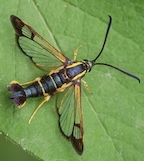 Dogwood Borer (DWB) Synanthedon scitula (Harris), a clear wing moth, infest the trunks of trees, contributing to tree decline. The use of DWB mating disruption (MD) has contributed greatly to the management and reduction of DWB infestation over the past 10 years in Hudson Valley orchards.
Dogwood Borer (DWB) Synanthedon scitula (Harris), a clear wing moth, infest the trunks of trees, contributing to tree decline. The use of DWB mating disruption (MD) has contributed greatly to the management and reduction of DWB infestation over the past 10 years in Hudson Valley orchards.
Yet, orchard edges adjacent to home owner and wooded sites containing infested ornamental Dogwood trees remain vulnerable to DWB infestation. in 2024, M9 / Fuji on hillside blocks showing DWB infestation were observed in MD management treated blocks.
Tarnished Plant Bug (TPB) Lygus lineolaris, presence in combination with other members of the plant bug complex including Mullein Plant Bug were observed at low numbers during the early season in abandoned or unmanaged trees, causing low to moderate fruit injury levels (0 – <8%) ,
found to be below the seasonal average. Orchards with historical fruit damage from TPB required timely applications for management in orchards shortly before and after petal fall. Injury occurred primarily during the pre-bloom period this season as warm temperatures prior to bloom were conducive to TPB activity.
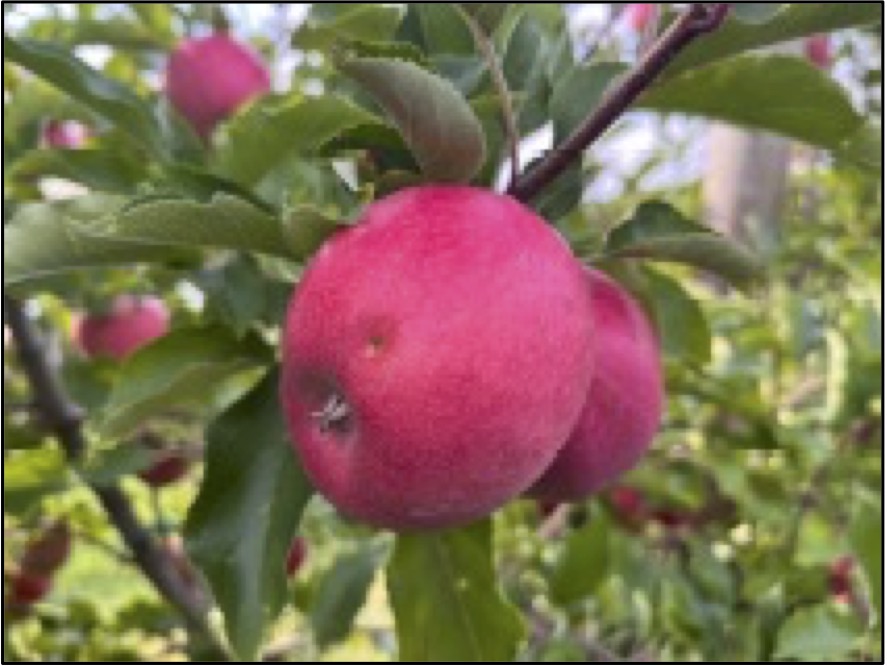
TPB fruit injury occur from Tight Cluster to 1st cover. Photo of Pink Lady with TPB injury nearing harvest.
Injury from this pest was observed to be at <0.5% by the 26th of May in the UTC varieties this season with small smooth raised protuberances (MPB) and more typical inverted punctures (TPB) found on sampled fruit. Observed TPB injury during harvest fruit evaluations in Ginger Gold in 7th August in untreated plot ranged between 1.0-5.0%.
Scout for TPB along perimeter rows and edge of ponds where broadleaf plants reside. Employ yellow traps hung at knee height to monitor populations. Applications should be made at trap threshold or at 1st sign of feeding, 1st sap droplets or 1st TPB on foliage or flowers.
Plum Curculio (PC) Conotrachelus nenuphar is a primary pest of apple. The beetle can cause significant ovipositional (egg-laying) injury to newly developing fruitlets beginning at 4mm fruit diameter shortly after petal fall and every season. The larva feed within the fruit burrow into the ground, emerging to become the subsequent summer generation, arising to feed on developing fruit prior to moving to overwintering sites.
PC emergence was delayed in 2024, with ovipositional injury occurring during the two weeks following petal fall (14th May). This delay in emergence was due to cold temperatures shortly after fruit set. Additionally, the Macoun block, a late developing variety, was used in our efficacy screening studies that was established in a colder, lower elevation site. First observation of PC presence and damaged fruitlets occurred on the 21st May (<1%).
Damage levels were moderate to severe this season with 56% ovipositional injury assessed on the 2nd August in untreated Macoun fruit.
Assessments were separated into two categories. including early oviposition scaring and late season feeding injury by PC up to harvest. Fruitlets had exceeded 8 mm in diameter at which time 5.0% PC injury was observed at 7 days post PF. PC ovipositional injury to fruit remained moderate to severe in UTC trees into the season expressing 18-60% injury. The 2nd generation feeding injury was high due to the number of trees which, were untreated buffer trees and or untreated whole rows.
European apple sawfly (EAS) Hoplocampa testudinea (Klug) activity occurred in relatively high numbers observed on a single Orange Co. orchard this season in which Petal Fall management was delayed due to cold temperatures, delay in PC emergence post fruit set. Fruit injury occurred in Fuji and Snapdragon. Research block cluster fruit evaluations at early harvest assessments of Macoun for EAS found < 0.1% fruit injury. This was the first of eight years in which EAS populations showed increased presence and fruit injury. Yet, still generally low fruit damage levels across commercial and abandoned pome fruit orchard blocks.
Spotted Tentiform Leafminer (STLM) Phyllonorycter blancardella adult populations remain at very high levels in seasonal pheromone trapping showing two distinct flights. Yet, since the planting of semi-dwarf trees, which correlates with the onset and use of the neonicotinoid class of insecticides employed in apple, and coinciding with the reduced use of broad spectrum OP use, has led to increased parasitic biological control of the larval stage. As such, the STLM has not been observed to cause mature injury to foliage to a degree requiring directed insecticide management. Seasonal parasitism of early larval stages continues to be observed in trees with ‘soft’ insecticide programs while neonicotinoid use for green apple aphid (GAA) and rosy apple aphid (RAA) management in spring, indirectly inhibiting STML larval development.
San Jose scale (SJS) Quadraspidiotus perniciosus (Comstock), is an Asian invasive pest with 2-3 generations/season. It overwinters in and infests apple trees and fruit. The crawler emergence of the 1st generation was predicted to occur during the second week of June (2nd – 7th June), with biofix based on the 1st adult pheromone capture on 18th May, using a 260-360 DD50BE model. Second generation was predicted based on second flight occurring 15th July. In general, SJS scale levels were low in infested trees. The infestation means ranged from 0.5% to 5.0% fruit injury observed in research plots on 19th August representing combined 1st and 2nd generation fruit infestation levels. In conventionally treated orchards, the SJS has become a major insect pest to manage in apple, requiring targeted applications for multiple generations. In recent years we’ve observed a 3rd generation in late September. Additionally, another lesser known scale, the prunicola scale, Pseudaulacaspis prunicola, have begun to infest southeastern NY and CT home orchards, characterized by a whitewashed appearance of white scale clusters appearing on the trunk and scaffold branches.
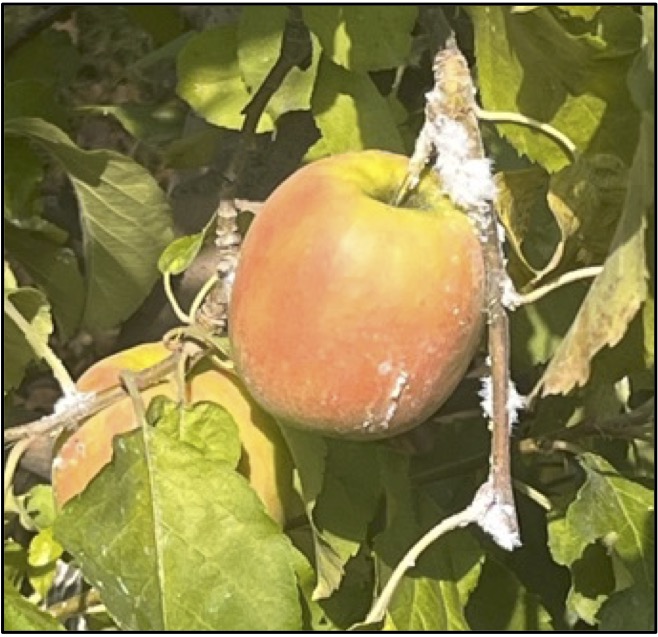
WAA colony feeding on terminal shoot stems and leaf petioles adjacent to fruit, often causing calex end infestations and sooty mold from excreted sugar droplets.
Wooly Apple Aphid (WAA) Eriosoma lanigerum (Hausmann). Populations of Wooly Apple Aphid were observed during the early pre-bloom period, in which they appeared to have overwintered successfully during the mild winter temperatures. This species of aphid are well protected within a cottony coating, feeding on the sap from succulent plant tissue. Feeding often causes ‘bark splitting’, while excreting or ‘shunting’ of excess and concentrated sap (Honeydew) acts as a substrate for the fungal sooty mold development on foliage and fruit, making the harvest of fruit quite difficult for workers. High populations give way to the colonization of aphids development of harborage within the calyx end of fruit that remain in cold storage after harvest.
The WAA can during years of mild winters can be found overwintering in pruning cuts. A large segment of the subterranean population which, feed on roots during the winter, emergence as crawlers that move into the canopy of pruning cuts and developing shoots. Populations can escalate during the season requiring targeted applications of specific insecticides such as the systemic active material. Spirotetramat, under the brand names Movento.
Management was achieved over the past two seasons through the repeated use of the neonicotinoid class, employing Imidacloprid (Admire Pro; Early – Late June for Rosy and Green Apple Aphid (RAA/GAA), Potato Leafhopper (PLH)) and Acetamiprid (Assail 30SG; Early July-Mid August for Apple Maggot (AM)) in repeated 2-week applications throughout the mid-latter season.
The Lepidopteran complex: Overwintering larvae of the Spotted Green Fruit Worm (SGFW), Obliquebanded Leafroller (OBLR), and newly emerging adults of the Red Banded Leafroller (RBLR) (Image left) were present during the pre-bloom period through fruit set, remaining a concern for most Hudson Valley and Lake Champlain pome fruit growers. The tools for use against the lepidoptera complex are diverse in mode of action, effective, and have excellent residual activity. Growers tend to lean heavily now on the use of the highly effective Diamide and Spinosyn groups for Lep. Management. Mid-late season leafroller damage levels of infestation were observed in harvest ratings for ranging between 3.0-30.0% injury at harvest of Macoun in mid- August.
Codling Moth (CM) 1st generation sustained adult flight and biofix of 4 moths occurred on 14th May, employing Trece pheromone lures and standard Tent Traps. First hatch / larval emergence was predicted for 27th May using 220 DD50BE from CM biofix. Complete hatch of 1st generation was predicted by 23rd June. Frass from CM larval feeding within fruit was observed in early July. The internal lepidopteran complex, lesser apple worm (LAW), oriental fruit moth (OFM), and codling moth (CM), showed relatively high levels of damage to apple, with frass produced by the internal lepidopteran complex appearing during mid-late July.
The 2nd generation adult emergence followed by sustained catch for the CM biofix predicted on 24th of June with management for larval emergence prediction using 250 DD50BE to occur on July 24th.
Damage from 1st and 2nd generation CM evaluated at harvest on Macoun showed 24.0% injured fruit in screening trials of most infested treatment. Codling moth differs from LAW and OFM as it feeds into the carpel and on the seed, while the others do not.
Obliquebanded Leafroller (OBLR) monitoring and management by tree fruit growers continues to be a high priority, albeit significantly lower levels of fruit injury is attributed to the leafroller complex in fruit pack-out assessments. By targeting up to three seasonal application windows while employing a single mode of action for each management window, growers can achieve successful management of OBLR larvae. Recommended application windows include the pre-bloom through petal fall period for the overwintering generation, often using Bt during bloom, IGR’s such as Proclaim and Intrepid at petal fall, the summer generation using either Harvanta, Altacor or Delegate, and later in August applying either Delegate or Altacor in rotation for resistance management. Recommendations for applications were made using insect phenology predictions for early emergence, using 340 DD50BE from biofix to manage emergence of larvae, predicted to occur on mid-June. In general, low levels of leafroller feeding were observed on developing foliage and fruitlets in spring 2024. Trap captures began on 31st May and were low to moderate for 1st generation OBLR. The 340 DD43BE emergence date of 1st summer OBLR generation was 14th June. The 2nd generation flight began on the 27th of July with larval emergence predicted for the 14th of August. OBLR trap numbers were moderate during August.
Apple maggot (AM) Rhagoletis pomonella (Walsh) continues to be a primary pest, requiring yearly management, based on an initial 5 fly/trap trap action threshold in apple production. Commercial orchards adjacent to abandoned apple trees with prior year fruit often have emerging and migrating AM flies traveling into and infesting commercially managed perimeter trees if left unprotected. The first emergence of AM this season was observed on the 8th of July from abandoned orchards with trap threshold occurring August 26th in traps placed in perimeter rows of a commercially managed orchard. A perimeter Gala block in Clintondale, NY became infested with oviposition sites, yet larva did not develop to burrow into the fruit. The use of Assail 30SG for AM management is very effective, yet, it has very limited efficacy to kill adult AM flies. However, it will effectively inhibit oviposition and kill developing larva when eggs are laid and hatch under the skin. (Reissig).
The brown marmorated stink bug (BMSB), Halyomorpha halys, is an Asian invasive pest, with feeding intensifying on apple from mid-August through November. For the past 15 years BMSB continues to be captured in pheromone traps throughout the southern Hudson Valley, with the initial BMSB confirmation in NYS on December 2008. By 2012 BMSB populations escalated in suburban and urban environments and throughout the growing regions in the southern to Mid-Hudson Valley. During that same year, late season varieties including Golden Delicious, Fuji and Pink Lady were most vulnerable as fewer fruit were available to a developing 2nd generation nymph and adult BMSB population. Feeding injury exceeding 21% in these varieties across orchards in Ulster and Orange counties. We’ve observed from research based voltinism studies that a second generation has occurred over the past few years, developing in mid-late August with oviposition and newly emerging nymphs from mid-August through September, dramatically increasing the regional population in any given year. Yet, since 2020 we’ve observed decreasing populations in urban environments, and as such, becoming less of an economic pest on farms throughout the lower to mid-Hudson Valley region. This reduction has likely been attributed to the adventive egg parasitoid Samurai Wasp Trissolcus japonicus, in association with an array of predatory insects, fungal pathogens such as Beauveria bassiana and select bird species (such as Bluebirds, Starlings, Wrens…).
In 2024, there appeared to be orchard sites above the trap threshold of 10 adult BMSB/Trap/Wk. associated with moderate levels of stink bug feeding in apple. We continue to recommend threshold based management timing for tree fruit production. Growers then rely on the pyrethroid class withacitve ingredient providing highest efficacy for BMSB. These include Bifenthrin (Ex. Brigade 2EC) in rotation with Fenpropathrin (Ex. Danitol.2.4EC), Cyfluthrin (Baythroid 2E) and the Pre-Mix pyrethroid ((Leverage 360) (beta-Cyfluthrin)/ neonicotinoid (Imidacloprid)) amongst other options. These programs are also efficacious against green stink bug, Acrosternum hilare as both species being arboreal / deciduous tree insects, contribute to seasonal fruit injury along wooded orchard perimeter.
The Champlain Valley also observed BMSB in traps exceeding threshold this season while fruit injury in WNY continues along the Lake Ontario fruit growing region in low to moderate levels of fruit injury. As such, we continue to employ a trap threshold of 10 total BMSB adults per trap per week
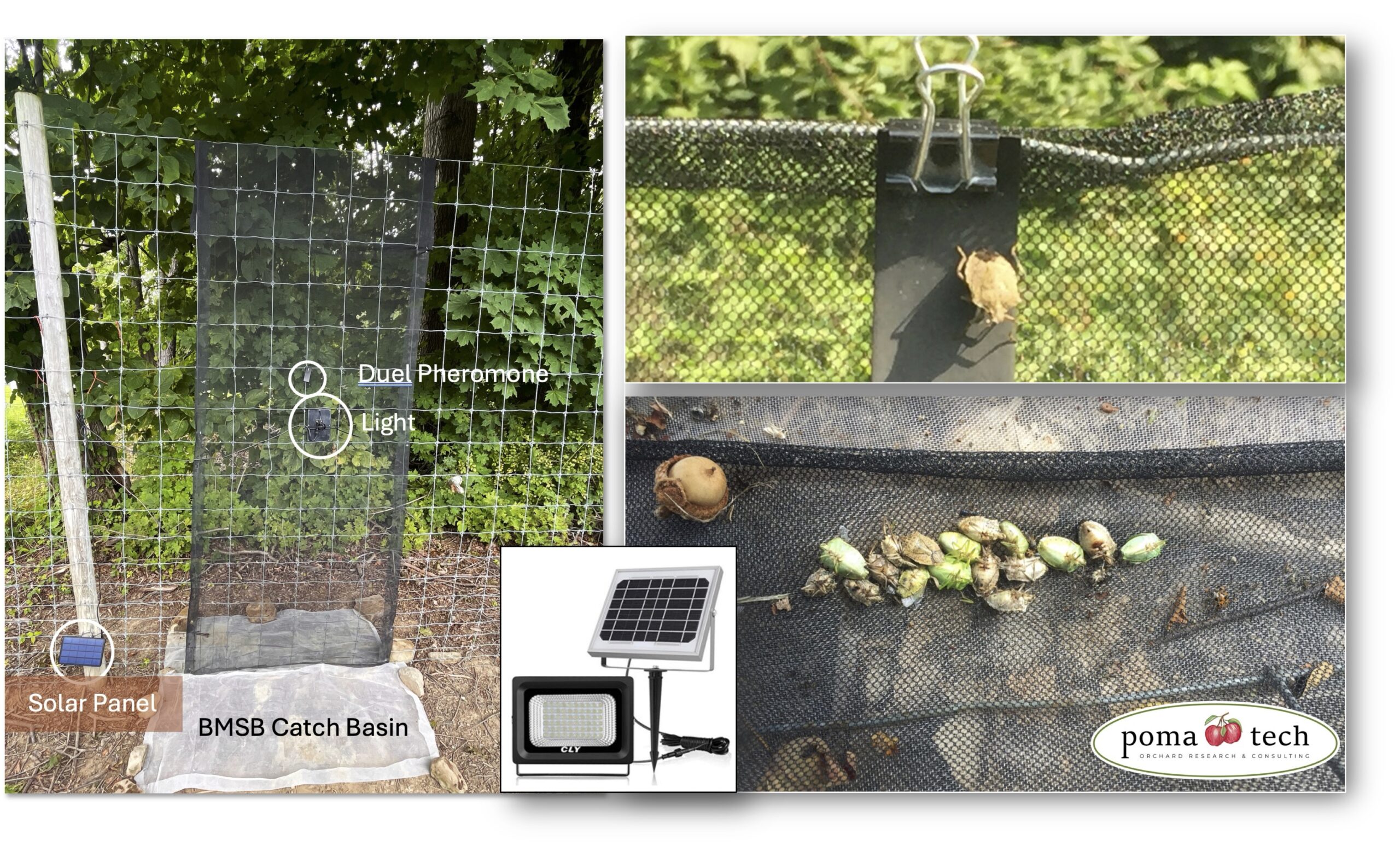 Research: The need to reduce late season residue from pyrethroid applications for BMSB continues to challenge production of late season varieties. As markets require more conservative minimum residue levels (MRL’s) here and abroad, alternative pest management approaches need to be evaluated and implemented. Over the past 3 years, the BMSB and GSB populations have been at relatively low levels based on Tedder Trap captures in comparison to the previous 5-15 years (see 2024 regional HV BMSB TTrap capture data below). Yet, we continue to find BMSB trap numbers above threshold in many Hudson Valley orchards, especially along the orchard / woodland edge, where host trees such as tree of heaven reside.
Research: The need to reduce late season residue from pyrethroid applications for BMSB continues to challenge production of late season varieties. As markets require more conservative minimum residue levels (MRL’s) here and abroad, alternative pest management approaches need to be evaluated and implemented. Over the past 3 years, the BMSB and GSB populations have been at relatively low levels based on Tedder Trap captures in comparison to the previous 5-15 years (see 2024 regional HV BMSB TTrap capture data below). Yet, we continue to find BMSB trap numbers above threshold in many Hudson Valley orchards, especially along the orchard / woodland edge, where host trees such as tree of heaven reside.
To address these low yet populations of stink bug damaging fruit this season, we tested a relatively low cost attract and kill system to prevent fruit feed injury from BMSB (Image above). We employed pyrethroid impregnated Vestergaard PermaNet®, plus pyrethroid bi-weekly applications of Bifenthrin to refresh netting, secured to perimeter deer fencing employing a garment tag gun of folded corners of net onto fencing. Additionally, a single dusk to dawn solar light was affixed to the net with zip ties, facing away from the orchard, as BMSB are highly attracted to lighting at night. We then placed duel BMSB pheromone attached to the center of the netting using garment tags. Perimeter ATK stations, set at 30 meters along late season fruit orchard block along perimeters providing management of late season stink bug feeding injury to fruit in commercial orchard sites.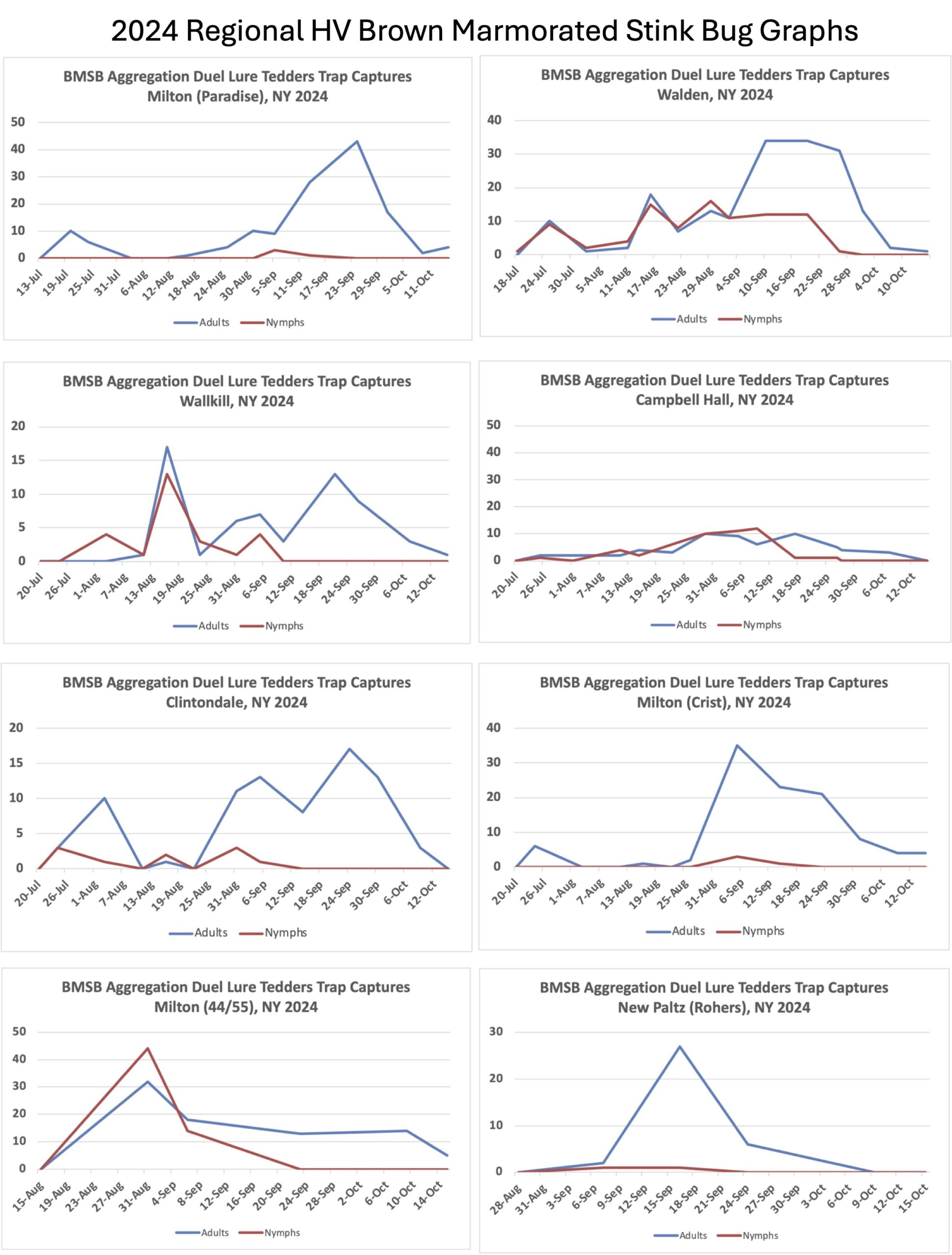
Winter injury continues to occur in well managed apple orchards and contributes to trunk injury and stress, causing the tree to produce EtOH which, acts as a trigger for BSB infestation. Studies from the CALS lab of Jason Londo suggest M.9 is the least cold hardy of the rootstock series studied, while G.41 retained its deep cold hardiness throughout the sampled months (Nov.-Jan). In this study, de-acclimation was evident for G.222, G.890, and G.935, which all lost substantial hardiness between December and January, which can lead to injury during a late season freeze event.
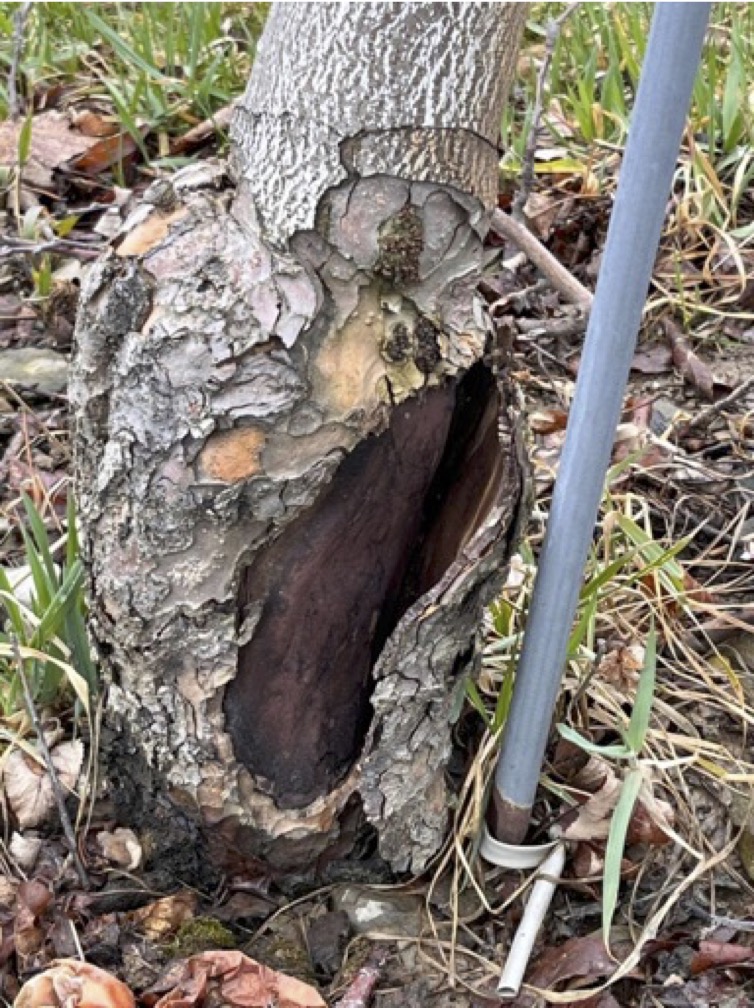 Apple trees can also experience rootstock and scion injury in compromised soil conditions in the Hudson Valley. Injury is often but not exclusively found trees growing in low-lying sites and hillside ‘depressions’, sunken tree rows where water accumulates and is retained for extended periods or inversely, sites of shale ‘dry’ soils in which irrigation water is unable to fulfill tree requirements. ‘Drought’ conditions from lack of water holding soil, such as alluvial and shale soils can cause significant tree stress. This scenario can result in splitting and separation of bark from the trunk (Image left), loss of live cambium, leading to subsequent tree death as fruit growth requirements impose excessive tree stress due to inadequate water movement capacity.
Apple trees can also experience rootstock and scion injury in compromised soil conditions in the Hudson Valley. Injury is often but not exclusively found trees growing in low-lying sites and hillside ‘depressions’, sunken tree rows where water accumulates and is retained for extended periods or inversely, sites of shale ‘dry’ soils in which irrigation water is unable to fulfill tree requirements. ‘Drought’ conditions from lack of water holding soil, such as alluvial and shale soils can cause significant tree stress. This scenario can result in splitting and separation of bark from the trunk (Image left), loss of live cambium, leading to subsequent tree death as fruit growth requirements impose excessive tree stress due to inadequate water movement capacity.
Additionally, herbicides have been implicated in causing significant injury to trunks of trees which, may also play an important role in trunk bark separation during yearly and seasonal repetitive herbicide applications. Conditions leading to chemical penetration into the bark to cause injury to the cambium, such as industry formulation changes or the addition of adjuvants, may increase the likelihood of trunk injury.
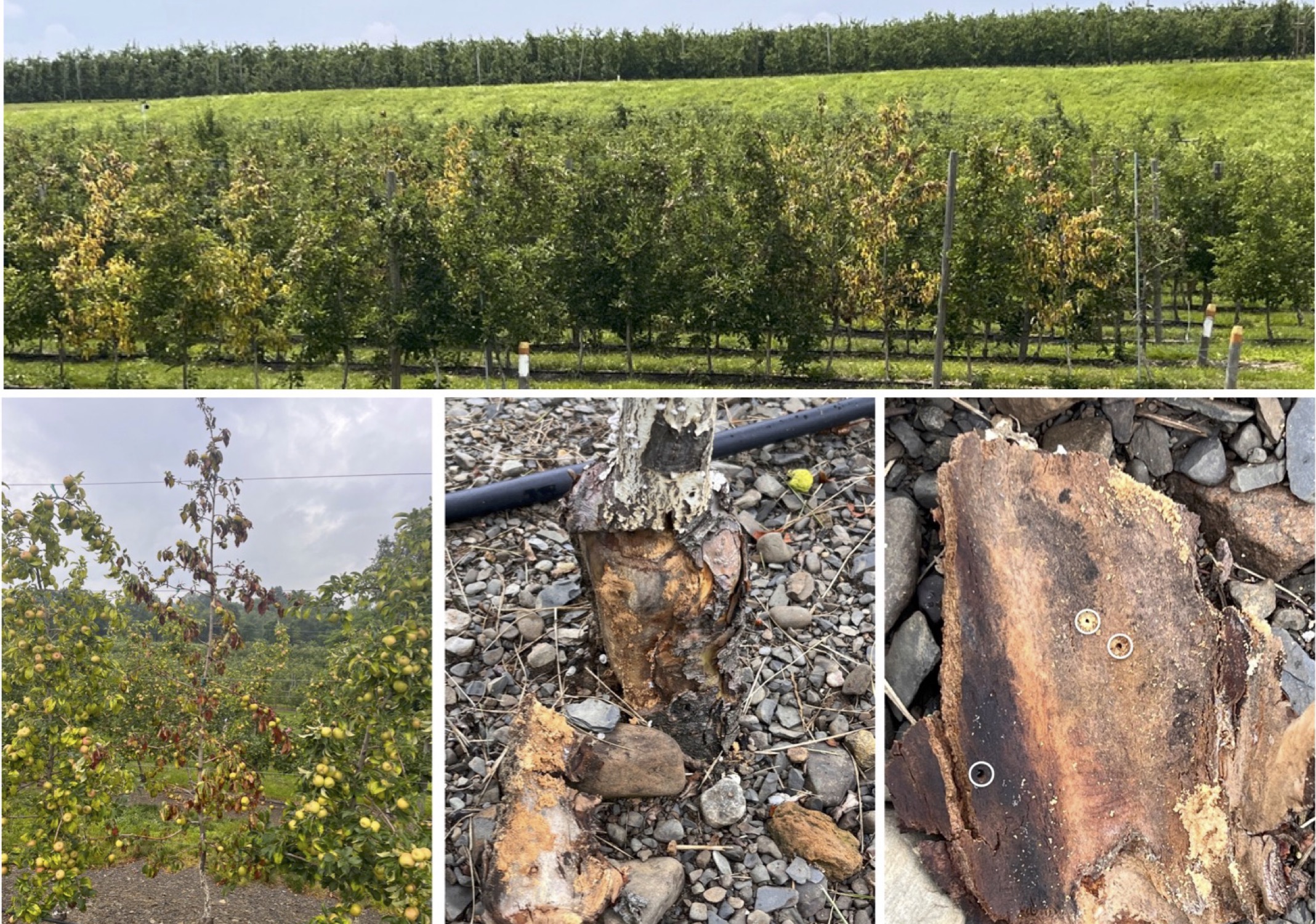
Wildfire Gala collapse ( Image: Yellowing trees in flat sustained wet soil orchard block . Left: Wildfire Gala G11 row on shale); Mid. Flaked Bark / BSB Frass. Right. BSB infestation with entry sites.
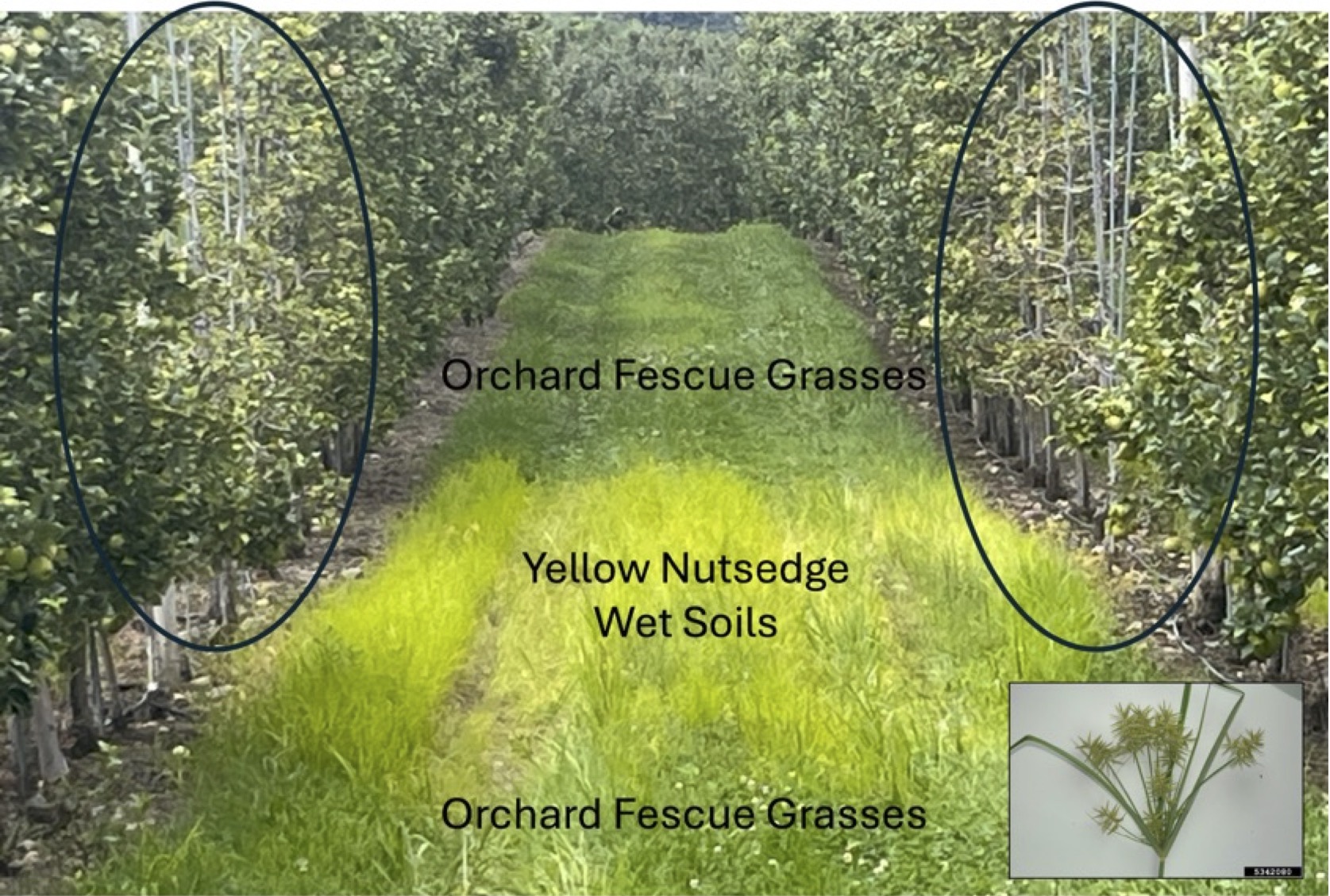
Tree decline in low-lying orchard depressions indicated by Yellow Nutsedge which, is known to inhabit wet soils.
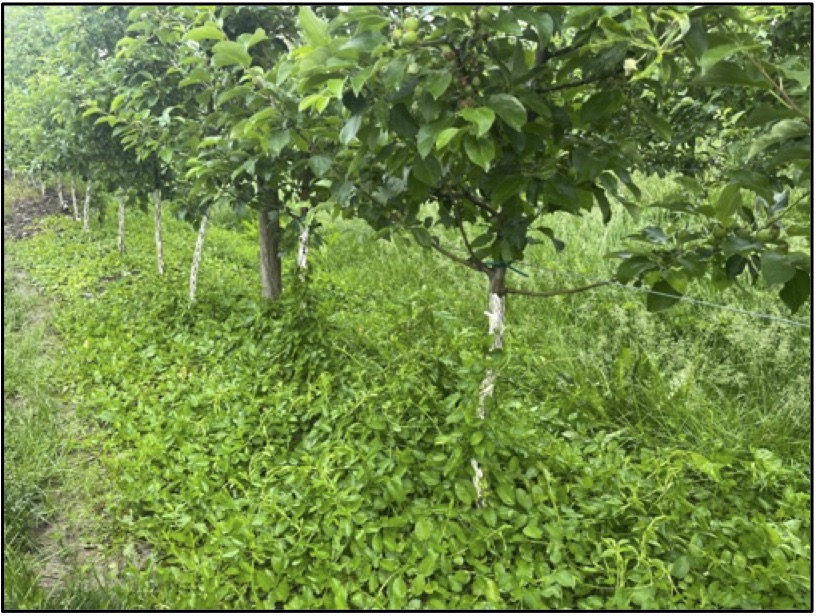 The regional orchard weed complex requiring was comprised of a broad host of plant species in both tree and drive rows including: Bindweed (image Right), Canada Thistle, Creeping Yellowcress, Dandelion, Knotweed, Pigweed (Lambsquarters), Mulberry, Oriental Bittersweet, Ragweed, Sumac, Tree of Heaven, Yellow Nutsedge, and perennial grass species …
The regional orchard weed complex requiring was comprised of a broad host of plant species in both tree and drive rows including: Bindweed (image Right), Canada Thistle, Creeping Yellowcress, Dandelion, Knotweed, Pigweed (Lambsquarters), Mulberry, Oriental Bittersweet, Ragweed, Sumac, Tree of Heaven, Yellow Nutsedge, and perennial grass species …
Climate Influences On Pest Management
Under Dry or Drought Conditions
1″ of rain or less per week over successive weeks
Benefits
- Longer pesticide residual ( Exception: Bt – Dipel susceptible to UV Light….)
- Reduced incidence of disease (Apple Scab, bloom and shoot ‘Fireblight’)
- Reduced and or delayed emergence of Apple Maggot due to dry soils (June-Aug.)
- Increased Phytophagous beneficial mites ( low fungi pathogens )
Deficits
- Increased incidence of Mildew in shoot leaves
- Increased foliar feeding from ERM, TSSM, Aphids
- Increased success of Lepidopteran larva ( low fungi pathogens )
- Increased stink bug activity
- Increased bird feeding of fruit
Under High Moisture
High Relative Humidity & Frequent Rains
Benefits
- Increased biological control of insects and mite species
- Beauveria bassiana ( may be influenced by prior season conditions for fungal success)
- Entomophaga maimaiga species specific for Spongy (Gypsy) Moth (requiring summer rain events)
Deficits
- Decrease in Pesticide Residual
- Increased disease pressure (Apple scab, Fire Blight)
- Standing water causing tree anoxia (prompting production of EtOH ethylene increasing ambrosia beetle infestation)
- Trees in depressions of standing water become susceptible to Ambrosia Beetle infestation
